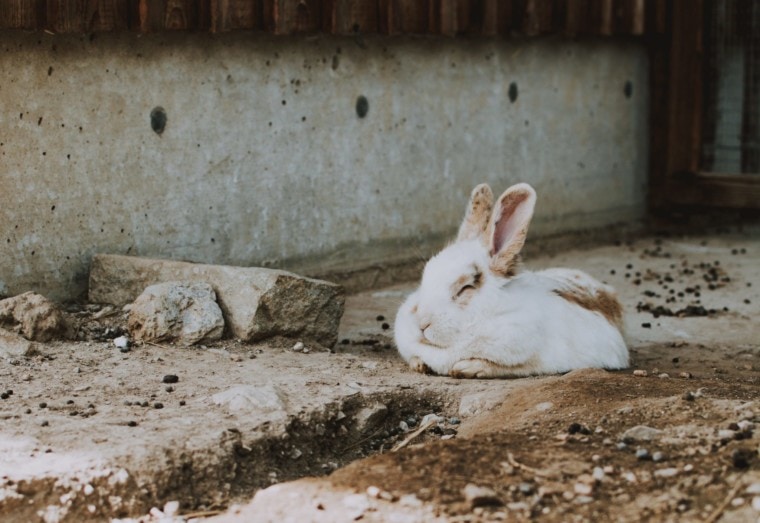
When you make the choice to bring a rabbit into your home, it means that both you and your rabbit will be adjusting to each other’s sleep schedules. But if you’ve had a bunny for even a short time, you’ll likely know that they don’t sleep at the same times as people.
This lack of similar sleeping hours can be a source of stress for new and long-time rabbit owners alike. Rabbits have developed a crepuscular sleeping rhythm that, in the wild, helps them to avoid predators. In the home, though, it can lead to early morning noise that disrupts our own sleep patterns.
In this article, we’ll be covering the basics of when and how much rabbits sleep, as well as discussing putting your bunny in a “trance”. Then, you’ll get plenty of helpful tips and hints to help your rabbit sleep well and wake up quietly. By the end of this guide, you’ll be fully prepared to make the best out of your rabbit’s alternative sleeping habits.
When Do Rabbits Normally Sleep?
There are three basic sleeping rhythms for animals:
- Nocturnal animals are most awake at night.
- Diurnal animals are most alert during the day.
- Crepuscular animals are most active at dawn and dusk.
Because of their status as prey animals, rabbits have developed several traits that help them avoid predators – including their crepuscular sleep cycle. By being most active and dawn and dusk, rabbits take advantage of the obscure light at those times to remain hidden from predators.
Unlike humans, rabbits do not sleep in one continuous chunk. Instead, you’ll find your rabbit sleeping in two main blocks: One in the middle of the day, and the other in the middle of the night.
Do Rabbit Sleep with Their Eyes Open?
Yes! In fact, rabbits have a third eyelid that helps to keep their eyes moist while doing so. This is another adaptation to help avoid predators. When sleeping with their eyes open, rabbits can still sense changes in light that would indicate approaching danger.

How Can I Tell If My Rabbit Is Sleeping?
Because they can remain so alert and even appear to not be sleeping at all, it’s important to know when your rabbit really is sleeping. That way, you can be sure to leave them alone and let them rest.
Tell-tale signs that your rabbit is asleep include:
- Their nose stops twitching.
- Their breathing slows down.
- They “loaf” or flop on their side.
Any of these indicate that your rabbit is very comfortable, indeed, and able to fall asleep without fear of danger.
How Much Sleep Do Rabbits Need?
Rabbits need a similar amount of sleep as humans, with one National Geographic article from their July 2011 issue citing 8.4 hours as a healthy level. Of course, this will be broken up into multiple sections because of their crepuscular sleeping rhythm.
Should You Put Your Bunny in a “Trance”?
You may have seen one of the many videos going around YouTube showing how to “trance” or “hypnotize” your rabbit. Basically, this involves turning them on their backs and covering their eyes, until they seem to magically stop moving.
As cute as this may look at first glance, it is in fact a deeply irresponsible way to treat your rabbit.
In the wild, rabbits have very few abilities to defend themselves; therefore, they have developed so many ways to avoid confrontation with predators. The reflex that hypnotizing or trancing a rabbit takes advantage of is called Tonic Immobility – and it is a last-ditch fear response that’s extremely stressful for your rabbit.
In short, look for other ways to help your rabbit sleep. Leave trancing your rabbit as a final resort for if they need to be helped with an injury, but never perform it regularly to put them to sleep.

The 4 Ways to Help Your Rabbit Sleep Well
A few adjustments to your rabbit’s housing and living situation can go a long way towards helping them sleep longer and more soundly. Try the following tips to make sure your rabbit feels safe and comfortable sleeping in your home.
1. Make Them a Comfortable Bed
Be sure to give your rabbit a soft, cushy place to rest inside of their enclosure. It should be warm, plush, and comfortable.
2. Put Their Bed in a Safe, Quiet Place
Choose a dark corner of your home that is further removed from sources of noise, like hallways or doors. In the wild, rabbits sleep in well-hidden burrows; the more you can make their bed feel like this, the better they’re likely to sleep.
3. Turn Out All the Lights
Rabbits are extremely sensitive to light and can be kept from sleeping well if there’s even a small source of light in the room. Be sure to turn out all the lights in the room where your rabbit sleeps and draw the shades on any window that might let in light.
4. Make Sure They Get Plenty of Exercise
If you give your bunny plenty of room to run around and play during their waking hours, they’ll sleep much better at night. Whenever possible, play with them in the early morning and early evening hours when they’re most awake.
Final Thoughts
Making sure your rabbit gets enough sleep is essential to their health. While it might be tempting to “hypnotize” your rabbit when they’re awake at odd hours, it’s a very stressful thing for them and should be completely avoided. Instead, look to make their sleeping situation as quiet, dark, and comfortable as possible to help them get better sleep and stay asleep longer. Thanks for reading, and we hope that you and your rabbit can both get plenty of good rest!
Featured Image Credit: fotografierende, Pexels









